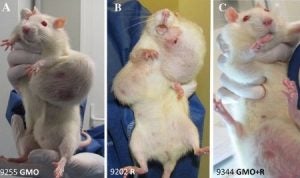Five years ago the news rocked the world. Images of three grotesque rats penetrated social media, and were bannered across the headline space of thousands of websites. The image came from a scholarly paper that claimed a relationship between ingredients from engineered crops and tumors.
The response was immediate. Scientists examined the work and noted its many shortcomings. On the other hand, activists touted the work’s veracity, representing it as proof-positive that such technologies were deadly. Some governments viewed this report as a precautionary shot-across-the-bow and halted all use of genetically engineered crops. One of those nations was Kenya, a country that has serious food security issues and could benefit from new technology.
And today the image is still used as rhetoric against safe technology that could feed more people and decrease the cost and environmental impact of farming.
What can learn about the paper, the authors, and the claims just from those panels of the figure?

Here are the famous three panels from Figure 3 in the original paper. I’m not going to link it. If you are interested in a deep dive on the inadequacies of the statistics, the poor pathology work and the details around the paper see the reports by Drs. Alison Van Eenennaam and Wayne Parrot.
What are some simple takeaways that tell a lot about the work, the ethics of authors, and the agenda of the publication?
The figure claims to show representative rats from animals fed “GMO”, animals fed herbicide (R), and animals fed “GMO” and herbicide. (I’m not sure why the image I have here is labeled A, B, C. In the original work it was J,K,L). Here are five important issues to note:
- Tumors in the control rat? What about the rat that ate a non-GMO, no herbicide diet? Where’s that? We don’t know. In the figure, the authors somehow forget to show it. If you look at Table 2 you see that control rats get tumors too. This is an important note because this omission suggests intent of the authors. If you show the control, then the figure loses its punch. How reviewers missed this is beyond me.
- Identical outcomes from remarkably different treatments. Does it not seem amazing that a technology used in genetic improvement and an herbicide would produce the same startling outcome? That should raise red flags. It says the experimental subjects (rats prone to tumors) are showing pathology independent of the treatment, not that the treatments cause the pathology.
- The state of laboratory animals. These animals have progressed to a horrendously painful, suffering state. If the authors were truly measuring tumor incidence they would have been able to stop when the tumors were the size of a pea and then humanely euthanized the animals. These animals were deliberately kept alive to grow bigger tumors, forced to suffer for this photo. This raises severe ethical questions about the author team. Their need for this shock photo exceeds their ethics for humane treatment and respect for lab animals.
- The use of the term “GMO.” If the figure was going to show a meaningful association between a treatment and effect, it would have precisely reported the nature of the treatment. “GMO” is not a treatment. It is not even a scientific term. A real figure would have simply noted the precise gene or genetic line changed. There is nothing inherently plausible in any transgenic plant that can cause tumors. If there was something specific about that line of feed, that should have been how the panels were labeled. This shows agenda. The authors needed the term GMO next to that rat for scare value.
- Five years later, no independent validation. Certainly if a technology used to produce ingredients in 70% of grocery store products was causing tumor growth in its consumers, that would be of scientific interest. But the story blew up in September of 2012 and then fell flat with the research community. There was no independent repetition of these results. There was no expansion of the study by other experts in tumor biology or oncology. It did not seed future research efforts or open new avenues of tumor and cancer research. The work was dead on arrival, which says a lot.
Again, this work was cited as justification to terminate use of genetically engineered crops in several countries. This paper, a political statement manufactured with poor scientific rigor, has a body count. This paper stopped deployment of crops in places where the world’s poorest subsistence farmers could have benefited. This paper let people go hungry, and when 21,000 people die every day from malnutrition, this paper is responsible for at least some of them.
Scholarly work became propaganda for a broken movement. Our scientific literature was exploited to propagate fear. A failed peer review kept food from the mouths of many.
Looking back at this paper, five long years ago, it reminds us that the best evidence an anti-scientific movement has does not fare well over time, and has serious consequences that harm those in need.
Kevin Folta is a land-grant scientist exploring ways to make better food with less input, and how to communicate science. This article was published with his permission. All of Dr. Folta’s funding can be found at kevinfolta.com/transparency.



